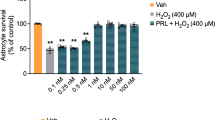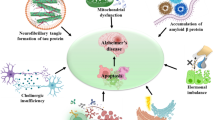Abstract
l-Glutamate plays a crucial role in neuronal cell death, which is known to be associated with various neurodegenerative diseases, such as Alzheimer’s, Parkinson’s, and Huntington’s diseases. In this study, we investigated the protective effects of biochanin A, a phytoestrogen compound found mainly in Trifolium pratense, against l-glutamate-induced cytotoxicity in a PC12 cell line. Exposure of the cells to 10 mM l-glutamate was found to significantly increase cell viability loss and apoptosis, whereas pretreatment with various concentrations of biochanin A attenuated the cytotoxic effects of l-glutamate. Specifically, the pretreatment led to not only decreases in the release of lactate dehydrogenase, the number of apoptotic cells, and the activity of caspase-3 but also an increase in the total glutathione level in the l-glutamate-treated PC12 cells. These results indicate that biochanin A may be able to exert neuroprotective effects against l-glutamate-induced cytotoxicity. Furthermore, our findings also imply that biochanin A may act as an antiapoptotic agent in order to perform its protective function.





Similar content being viewed by others
References
Coffey CE, Lucke JF, Saxton JA, Ratcliff G, Unitas LJ, Billig B, Bryan RN (1998) Sex differences in brain aging: a quantitative magnetic resonance imaging study. Arch Neurol 55:169–179
Asthana S, Baker LD, Craft S, Stanczyk FZ, Veith RC, Raskind MA, Plymate SR (2001) High-dose estradiol improves cognition for women with AD: results of a randomized study. Neurology 57(4):605–612
Llera DA, Ferreiro EA, Chowena JA, Argente J, Jim′enez LP, Frago LM, Barrios V (2007) 17β-Estradiol protects depletion of rat temporal cortex somatostatinergic system by β-amyloid. Neurobiol Aging 28:1396–1409
Bhavnani BR, Berco M, Binkley J (2003) Equine estrogens differentially prevent cell death induced by glutamate. J Soc Gynecol Investig 10:302–308
Mueck AO, Seeger H, Lippert TH (2002) Estradiol metabolism and malignant disease-review. Maturitas 43:1–10
Jin R, Horning M, Mayer ML, Gouaux E (2002) Mechanism of activation and selectivity in a ligand-gated ion channel: structural and functional studies of GluR2 and quisqualate. Biochemistry 41:15635–15643
Molnar E, Isaac JT (2002) Developmental and activity dependent regulation of ionotropic glutamate receptors at synapses. The Scientific World J 2:27–47
van Os S, Ruitenbeek W, Hopman J, van de Bor M (2006) Excitatory amino acid release and electrocortical brain activity after hypoxemia in near-term lambs. Brain Dev 28:380–388
Camins A, Pallas M, Silvestre JS (2008) Apoptotic mechanisms involved in neurodegenerative diseases: experimental and therapeutic approaches. Methods Find Exp Clin Pharmacol 30:43–65
Benveniste H (2009) Glutamate, microdialysis, and cerebral ischemia: lost in translation? Anesthesiology 110:422–425
Monaghan DT, Bridges RJ, Cotman CW (1989) The excitatory amino acid receptors: their classes, pharmacology, and distinct properties in the function of the central nervous system. Annu Rev Pharmacol Toxicol 29:365–402
Bleich S, Romer K, Wiltfang J, Kornhuber J (2003) Glutamate and the glutamate receptor system: a target for drug action. Int J Geriatr Psych 18:S33–S40
Choi DW (1988) Glutamate neurotoxicity and diseases of the nervous system. Neuron 1:623–634
Murphy TH, Miyamoto M, Sastre A, Schnaar RL, Coyle JT (1989) Glutamate toxicity in a neuronal cell line involves inhibition of cystine transport leading to oxidative stress. Neuron 2:1547–1558
Zablocka A, Janusz M (2008) The two faces of reactive oxygen species. Postep Hig Med Dosw 62:118–124
Tan S, Schubert D, Maher P (2001) Oxytosis: a novel form of programmed cell death. Curr Top Med Chem 1:497–506
Chen HQ, Jin ZY, Li GH (2007) Biochanin A protects dopaminergic neurons against lipopolysaccharide-induced damage through inhibition of microglia activation and proinflammatory factors generation. Neurosci Lett 417:112–117
Beal MF (1992) Mechanisms of excitotoxicity in neurologic diseases. FASEB J 6:3338–3344
Walton HS, Dodd PR (2007) Glutamate-glutamine cycling in Alzheimer’s disease. Neurochem Int 50:1052–1066
Su SJ, Chow NH, Kung ML, Hung TC, Chang KL (2003) Effects of soy isoflavones on apoptosis induction and G2-M arrest in human hepatoma cells involvement of Caspase-3 activation, Bcl-2 and Bcl-XL downregulation, and Cdc2 kinase activity. Nutr Cancer 45(1):113–123
Szliszka E, Czuba ZP, Mertas A, Paradysz A, Krol W. 2011. The dietary isoflavone biochanin-A sensitizes prostate cancer cells to TRAIL-induced apoptosis. Urol Oncol-Semin Ori. http://www.urologiconcology.org/article/S1078-1439(11)00043-3/abstract
Penugonda S, Mare S, Goldstein G, Banks WA, Ercal N (2005) Effects of N-acetylcysteine amide (NACA), a novel thiol antioxidant against glutamate-induced cytotoxicity in neuronal cell line PC12. Brain Res 1056:132–138
Penugonda S, Mare S, Lutz P, Banks WA, Ercal N (2006) Potentiation of lead-induced cell death in PC12 cells by glutamate: protection by N-acetylcysteine amide (NACA), a novel thiol antioxidant. Toxicol Appl Pharmacol 216:197–205
Di Monte D, Sandy MS, Ekstrom G, Smith MT (1986) Comparative studies on the mechanisms of paraquat and 1-methyl-4-phenylpyridine (MPP+) cytotoxicity. Biochem Bioph Res Co 137:303–309
Kume T, Katsuki H, Akaike A (2004) Endogenous factors regulating neuronal death induced by radical stress. Biol Pharm Bull 27:964–967
Parfenova H, Basuroy S, Bhattacharya S, Tcheranova D, Qu Y, Regan RF, Leffler CW (2006) Glutamate induces oxidative stress and apoptosis in cerebral vascular endothelial cells: contributions of HO-1 and HO-2 to cytoprotection. Am J Physiol Cell Physiol 290:C1399–C1410
Mao YR, Jiang L, Duan YL, An LJ, Jiang B (2007) Efficacy of catalpol as protectant against oxidative stress and mitochondrial dysfunction on rotenone-induced toxicity in mice brain. Environ Toxicol Phar 23:314–318
Froissard P, Monrocq H, Duval D (1997) Role of glutathione metabolism in the glutamate-induced programmed cell death of neuronal-like PC12 cells. Eur J Pharmacol 326:93–99
Muller WE, Romero FJ, Perovic S, Pergande G, Pialoglou P (1997) Protection of flupirtine on beta-amyloid-induced apoptosis in neuronal cells in vitro: prevention of amyloid-induced glutathione depletion. J Neurochem 68:2371–2377
Leon R, Wu H, Jin Y, Wei J, Buddhala C, Prentice H, Wu JY (2009) Protective function of taurine in glutamate-induced apoptosis in cultured neurons. J Neurosci Res 87(5):1185–1194
Wang X, Zhu G, Yang S, Wang X, Cheng H, Wang F, Li X, Li Q (2011) Paeonol prevents excitotoxicity in rat pheochromocytoma PC12 cells via downregulation of ERK activation and inhibition of apoptosis. Planta Med 77(15):1695–1701
Ma SW, Liu HX, Jiao HY, Wang LY, Chen LY, Liang J, Zhao M, Zhang XT (2012) Neuroprotective effect of ginkgolide K on glutamate-induced cytotoxicity in PC12 cells via inhibition of ROS generation and Ca2+ influx. Neurotoxicology 33(1):59–69
Cory S, Adams JM (2002) The Bcl-2 family: regulators of the cellular life-or-death switch. Nat Rev Cancer 2:647–656
Liu WB, Zhou J, Qu Y, Li X, Lu CT, Xie KL, Sun XL, Fei Z (2010) Neuroprotective effect of osthole on MPP+-induced cytotoxicity in PC12 cells via inhibition of mitochondrial dysfunction and ROS production. Neurochem Int 57:206–215
Acknowledgments
This research was supported by Research University Grant Scheme (RUGS 05-02-12-1860RU), Universiti Putra Malaysia (UPM). Ji Wei Tan is a recipient of Graduate research fellowship from UPM.
Author information
Authors and Affiliations
Corresponding author
Rights and permissions
About this article
Cite this article
Tan, J.W., Tham, C.L., Israf, D.A. et al. Neuroprotective Effects of Biochanin A Against Glutamate-Induced Cytotoxicity in PC12 Cells Via Apoptosis Inhibition. Neurochem Res 38, 512–518 (2013). https://doi.org/10.1007/s11064-012-0943-6
Received:
Revised:
Accepted:
Published:
Issue Date:
DOI: https://doi.org/10.1007/s11064-012-0943-6




